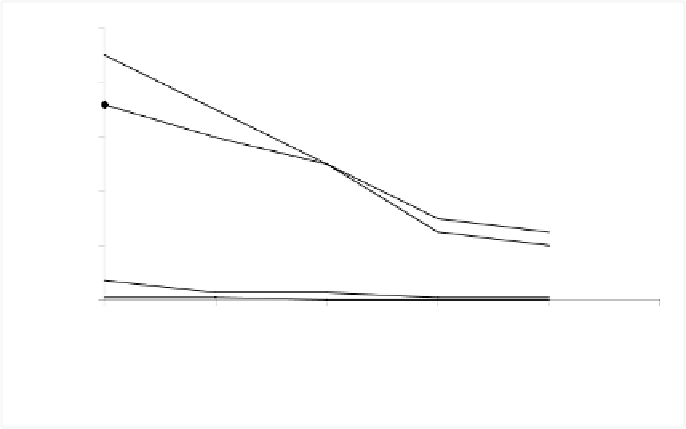Biology Reference
In-Depth Information
7LPHK
3URWHLQ
$PPRQLXP 2UWKRSKRVSKDWH
6&2'
Fig. 9.6
Protein, phosphate, ammonia and SCOD concentrations at 6.3 h HRT (Lim et al
.
,
2003).
Three strains of yeast,
Debaryomyces occidentalis
(P1),
Trichosporon
ovoides
(P19) and a strain that could not identifi ed (S27) were isolated from
a drainage canal of a fi sh canning factory. The strain
Trichosporon ovoides
(P19) was immobilised and inoculated into fi sh processing wastewater,
and cultured at 30°C. A total organic carbon decrease from 1.2 x 10
3
to
3.0x10
2
mg C/l per day was reported. In addition, a decrease in proteins
(from 600 µg/ml to 250 µg/ml) and reducing sugars (from 100 µg/ml to
60 µg/ml) was also recorded (Urano et al., 2002).
A commercial bacterial inoculum, called Biostart, was applied to
channel catfi sh (
Ictalurus punctatus
) ponds three times per week for 6 mon.
There were few signifi cant differences in concentrations of water quality
variables, whereas there were no signifi cant differences in bottom soil
carbon and nitrogen between treated with bacteria and control ponds.
Survival and net production of fi sh was signifi cantly greater in ponds
treated with the bacterial inoculum compared to controls (Queiroz and
Boyd, 1998).
Four strains of
Rhodocyclus gelatinosus
(T6, R4, R5, R7) were isolated
from the wastewater of seafood-processing plants and inoculated into
tuna condensate (diluted and undiluted), shrimp-blanching water or
effl uent from a frozen-seafood plant under anaerobic conditions in
light. Tuna condensate was the best medium for
Rhodocyclus gelatinosus
growth. Strain R7, gave the highest biomass production (4.0 g/l), cell
yield (0.32 g cell/g COD), and COD removal (78%) in 1:l0 (v/v) diluted




























